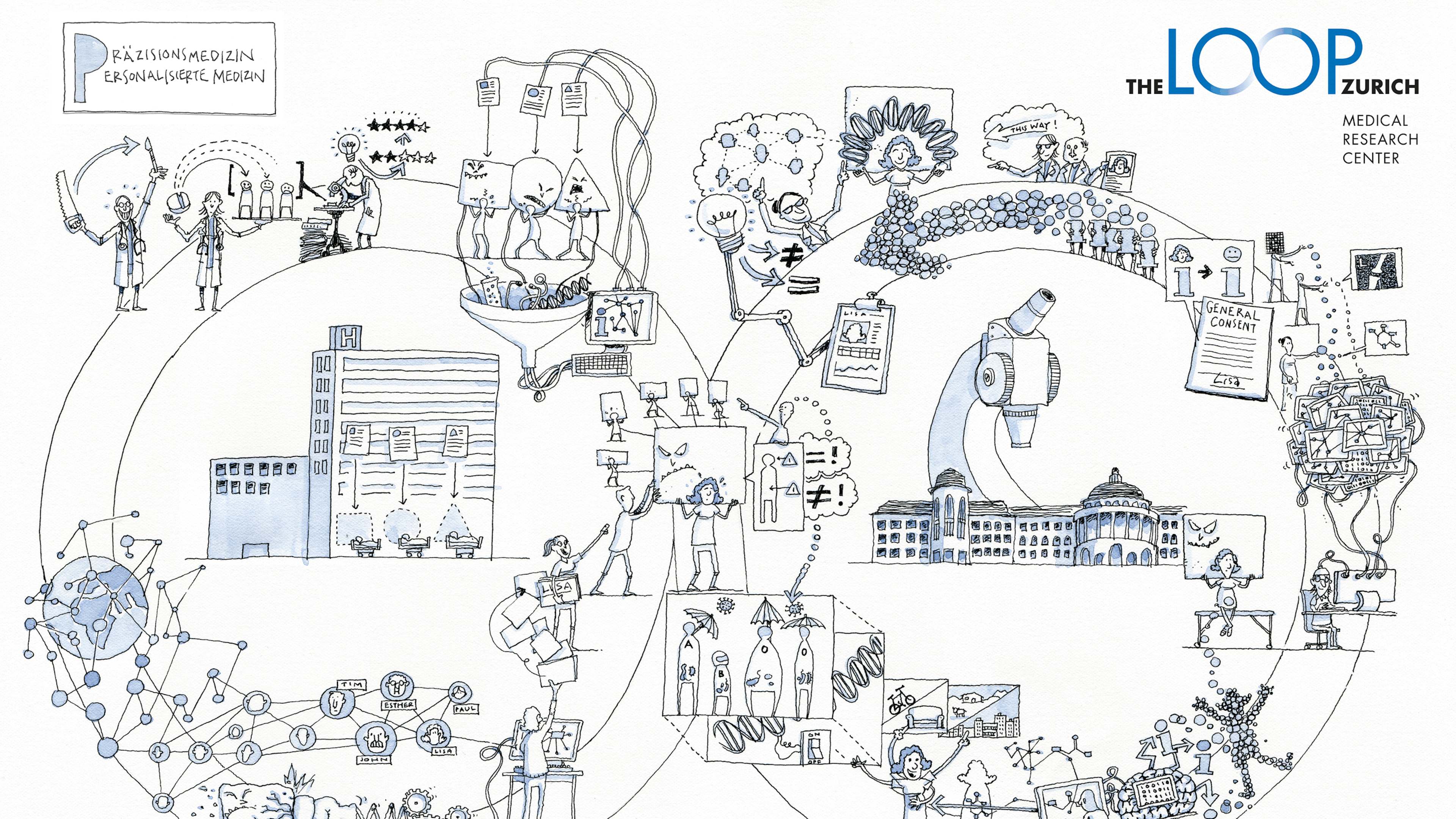The LOOP Zurich BMIP: Using the Zurich data
Health data can help to improve the treatment of patients. This is why the University of Zurich, ETH Zurich and the four university hospitals in the city are creating a joint platform for sharing data of this kind. The BioMedical Informatics Platform will be up and running by 2025.
Health data such as our blood group, weight and body temperature can help to adapt medical treatments as effectively as possible to our individual situation. For example, knowing a patient’s weight is important to allow the right dose of certain medicines to be prescribed and information about their blood group is essential in ensuring that they receive the right blood products.
Modern medical technologies and increasingly fast computer chips make it possible to collect and process more and more information about our bodies. If patients agree to the use of their data for the purposes of medical research, this is when things get exciting. Beatrice Beck Schimmer, Vice President Medicine Zurich (UMZH), says: «Large volumes of data are an important basis for precision medicine. They allow patterns to be identified that tell us how diseases develop and which treatments are effective.»
Huge potential
But are the existing data also being used? What is the situation in the four university hospitals in Zurich: University Hospital Zurich, University Children's Hospital Zurich, Balgrist University Hospital and the University Hospital of Psychiatry? «We are still not fully exploiting the huge potential of these data,» explains Beatrice Beck Schimmer.
The reason for this is that each hospital has its own IT system. The patient data are not always compatible with other systems and can therefore not easily be shared by the hospitals or used for research projects involving more than one hospital. The hospitals lack a shared digital infrastructure.
One platform for all
A solution to this problem is now in sight. The LOOP Zurich research center – a joint initiative of the University of Zurich, ETH Zurich and the four university hospitals – plans to establish a BioMedical Informatics Platform by 2025 that will allow health data to be shared. The LOOP Zurich was commissioned by Academic Medicine Zurich to develop the platform and the funding is being provided by the Government of the Canton of Zurich.
In the years to come, this will allow for the central management of research data in Zurich. «The goal is to enable the simple, efficient sharing of data among all the researchers involved. This lays important foundations for the long-term development of Zurich as a medical location,» says Professor Gunnar Rätsch, biomedical informatics specialist at ETH Zurich and co-project leader of the BioMedical Informatics Platform.

Gunnar Rätsch (ETH Zurich), co-project leader of the BioMedical Informatics Platform
Harmonized data
In specific terms, the system will function as follows: The four university hospitals will send the anonymized data that they have collected in each of their research projects to the new platform. There the data will be combined, stored and harmonized, which means converting them to a format that allows them to be shared by the individual hospitals. The aim is also to add diagnostic information from tissue samples in existing biobanks to the platform.
The strict data protection regulations that are already in force in the hospitals will apply to the platform. It will allow the potential of the data to be exploited even more effectively for use in the field of medicine. «The platform will enable us to run new, groundbreaking projects. This means that we can strengthen Zurich’s position as a research location and as an important international center of precision medicine,» says Beatrice Beck Schimmer.
Researchers in Zurich are already playing a leading role with a number of oncology projects. One example is the Tumor Profiler Project, where the molecular profile of tumors is identified so that patients can be offered a personalized treatment.
Back to the hospital
The BioMedical Informatics Platform will not only enable data to be stored and shared, but will also promote the development and networked use of artificial intelligence (AI) solutions. Algorithms are already helping with the reliable evaluation of medical images. In this area, researchers have already carried out groundbreaking work using data from the University Hospital Zurich. They include the team headed by Michael Krauthammer, who is Professor of Medical Informatics at UZH and co-project leader of the BioMedical Informatics Platform. The researchers have succeeded in developing an AI system that identifies at an early stage on medical images the damage caused by rheumatic diseases and automatically produces appropriate medical diagnoses.

Michael Krauthammer (University of Zurich), co-project leader of the BioMedical Informatics Platform
Therefore, Michael Krauthammer is certain that large volumes of data combined with artificial intelligence can help to reduce costs and take routine tasks away from physicians, giving them more time to spend with patients. At the same time, AI can contribute to improving the quality of treatments and allow for innovations, for example in the search for new active substances for use in medicines.
This is also the objective of the BioMedical Informatics Platform: to enable patient data to be used in research and to be fed back into treatments in the form of new findings. This means closing the LOOP.
Large volumes of accurate data
In the long term, this loop will extend far beyond Zurich. For this reason, the BioMedical Informatics Platform will meet the standards that are currently being developed by the Swiss Personalized Health Network (SPHN). This initiative of the Swiss Federal Government aims to allow health data to be shared throughout Switzerland for the purposes of research. The solution developed in Zurich will be integrated directly into the network via an interface and could even become a national role model for data-centered research.
However, medical data will be networked in the future for research and for the development of new therapies not only in Switzerland but all over the world. This is particularly important because increasingly precise profiles of individual patients will not be enough on their own. For example, in the case of a rare disease, there may only be two people in Switzerland who suffer from it, but on a global scale several hundred people could be affected. Global patient data will help researchers to identify common features and effective treatments. This is why the data must be not only precise but also available in large quantities.
This is clearly highlighted by the research being carried out by Professor Gunnar Rätsch from ETH Zurich. His team has worked with partner institutes to establish a global platform that allows data about two important breast cancer genes to be shared. These genes appear in many variants, some of which are very rare. Each variant presents a different risk of the woman developing breast cancer. The more comprehensive the database, the better women can assess their own risk and take appropriate action. Big data make the difference when it comes to receiving the best possible medical treatment. The joint informatics platform will enable researchers in Zurich to make the most of this opportunity.

Glossary
Big data:
Big data is the term used to describe the evaluation of large volumes of data from a wide variety of sources.
Health data:
These are data that relate to a person’s health condition. They include information about health (diseases, symptoms, therapies) and the results of lab tests, but also details of the person’s lifestyle (diet, smoking, etc.).
Medical informatics:
Medical informatics concerns the systematic collection, processing, storage and analysis of data and information from medicine and healthcare.
Precision medicine (previously known as personalized medicine):
Every person is different. The ways in which we become ill and recover also differ. In the field of medicine, it is already important to take into consideration individual factors such as age, gender and pre-existing conditions when treating a patient. Precision medicine incorporates new and comprehensive genetic and molecular data and information from medical imaging processes using the latest medical technologies and data analysis tools. This makes it possible to give a much more accurate diagnosis and to identify treatments that are tailor-made for the patient.

Credits
Text: Adrian Ritter
University of Zurich: Michael Krauthammer
ETH Zurich: Gunnar Rätsch





